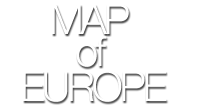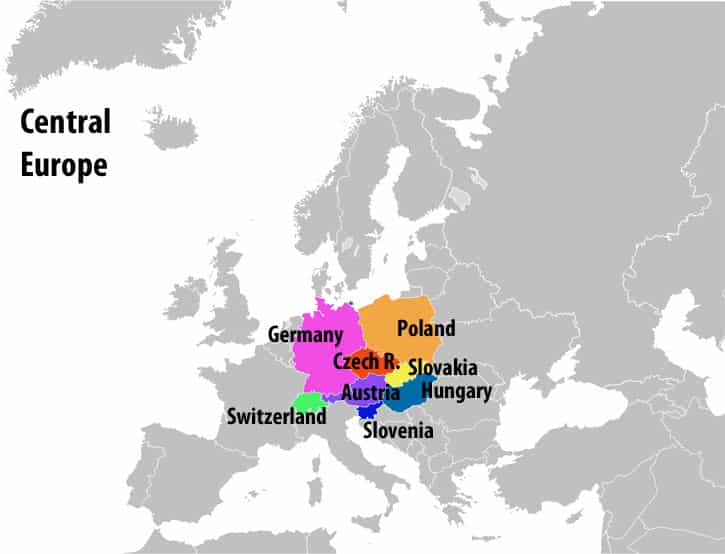Central Europe, a region often overlooked in the global discourse, holds a unique position in the world. Nestled between the Western and Eastern parts of the continent, Central Europe is a fascinating blend of cultures, histories, and geographies. This article delves into the intricacies of the map of Central Europe, exploring the countries that make up this region, the unique characteristics that set it apart, and the rich history that has shaped its present.
Which Countries Fall Under Central Europe?
Central Europe is a region that encompasses several countries. While the exact list can vary depending on the context, the most commonly included nations are Germany, Austria, Czech Republic, Slovakia, Hungary, Poland, and Slovenia. Some definitions also include Switzerland, Liechtenstein, and parts of Belgium, Netherlands, and France. Each of these countries contributes to the rich tapestry of cultures, languages, and histories that define Central Europe.
Is Central Europe the Same as Eastern Europe?
Central Europe is not the same as Eastern Europe, although the two regions share some commonalities. The distinction between Central and Eastern Europe is more than just geographical; it’s also historical, cultural, and political. Central Europe has a history closely tied to Western Europe, particularly through the Holy Roman Empire and the Habsburg Monarchy. In contrast, Eastern Europe has been more influenced by the Byzantine Empire and later, the Soviet Union.
The Area of Central Europe
Central Europe covers a significant area, spanning approximately 1 million square kilometers (or about 386,000 square miles). This region is home to diverse landscapes, from the towering Alps in Switzerland to the vast plains of Hungary. Each country within Central Europe boasts its own unique geography, contributing to the region’s overall diversity.
Why is it Called Central Europe?
The term “Central Europe” is used to describe the region lying between Western and Eastern Europe. The concept of Central Europe is largely a product of geopolitical and social constructs rather than strict geographical boundaries. The term gained prominence in the 19th century as a way to describe the area of Europe that was neither part of the West nor the East but had its own unique characteristics and identity.
The Oldest Country in Central Europe
When it comes to age, Hungary takes the crown as the oldest country in Central Europe. Established on December 25, 1000 AD, Hungary has a rich history that has significantly influenced the region. Other countries, like Poland and Germany, also have long histories dating back several centuries.
Is Greece or Croatia Part of Central Europe?
While both Greece and Croatia are part of Europe, they are not typically classified as part of Central Europe. Greece is generally considered part of Southern Europe, while Croatia is often categorized as part of Southeastern Europe or the Balkans. However, these classifications can vary depending on the context.
The European Union and Central Europe
The European Union (EU) is a significant part of the political, economic, and social fabric of Central Europe. Most Central European countries, including Germany, Austria, Hungary, Poland, and Slovenia, are members of the EU. These countries have benefited from EU membership through access to a single market, funding for development, and the ability to participate in decision-making processes that affect the entire bloc.
However, not all Central European countries are part of the EU. Switzerland and Liechtenstein, for example, have opted to remain outside the EU while still maintaining close economic and political ties with the bloc. These countries have negotiated numerous agreements with the EU to participate in certain aspects of the single market while retaining their sovereignty in other areas.
The EU has had a significant impact on the development of Central Europe. EU funding has contributed to infrastructure development, economic growth, and social programs in many Central European countries. Additionally, EU membership has facilitated the free movement of people, goods, services, and capital across borders, contributing to increased integration and cooperation among Central European countries.
However, EU membership also comes with challenges. Central European countries must comply with EU regulations and standards, which can sometimes be a source of tension. Additionally, these countries must contribute to the EU budget, which can be a significant financial commitment.
Despite these challenges, the EU remains a crucial part of Central Europe’s identity. The map of Central Europe is not just a geographical representation, but also a reflection of the region’s complex political and economic relationships. Whether through EU membership or close ties with the bloc, Central Europe is deeply intertwined with the broader European community.
Central Europe, with its rich history, diverse cultures, and unique geography, is a fascinating region to explore. Whether you’re interested in the historical significance of Hungary, the cultural diversity of Germany, or the geographical wonders of Switzerland, Central Europe offers something for everyone. So the next time you look at a map of Europe, take a moment to appreciate the intricacies of this captivating region.
===========================
There is no common standard of what actually constitutes Central Europe, in fact many of the countries that are defined under this title also form part of Eastern & Western Europe. For the purposes of this article I am going to define the following countries as forming Central Europe, which is the current definition held by the United Nations:
There are plenty of sights to see within Central Europe and I am going to take you through a number of them right now. Although of course whilst wandering around you will discover many other wonderful sightseeing opportunities.
- Almost everything located within Berlin, Germany is a sight in itself. A particular favourite amongst tourists is climbing the Reichstag Dome.
- Of course, no trip to Germany is complete without experiencing wonderful German Beer. The best way to do this is to go to the Beer Hall located in Munich. The Olympic Park is also located incredibly close by and is worth a visit.
- Also in Germany you can take the chance to visit ‘The Eagles Nest’ which was a location where Hitler helped to direct the German War.
- For the more adventurous amongst people there are plenty of natural sights to see when you hike through the mountains of Switzerland or drive through the rolling countryside gazing at many of the beautiful lakes around the area.
- Poland was almost destroyed during World War 2, particularly Warsaw. Take a look around the modern architectural wonders in the city which almost has been completely rebuilt but still in a more medieval style.
- There are plenty of concentration camps located within Poland. One of the most popular of course is Auschwitz. The reality of war really hits home when you visit one of these concentration camps.
- A particular favourite of those travelling to Central Europe to sightsee is travelling up ‘Castle Hill’ for fantastic views over Budapest, capital of Hungary.
- The ‘Rhine River’ travels through most of the countries in Central Europe and a cruise along this will take you to some of the best vineyards in the world. Perfect for wine lovers.
There is so much to do for sightseeing in Central Europe. Whether you are looking to enjoy the beautiful landscapes of Europe by hiking through mountains or driving through the countryside, or whether you want to experience the rich history which is evident in almost every major town located within Central Europe.
In my opinion if you are going to go sightseeing in Central Europe you should do it properly, for that reason take a chance to visit all nearby countries such as France, Spain and Belgium. Only then will you be able to get the full European experience. Plenty of cheap flights will take you to any of these destinations, after that it is simply a matter of hiring a car and hitting the open road.

